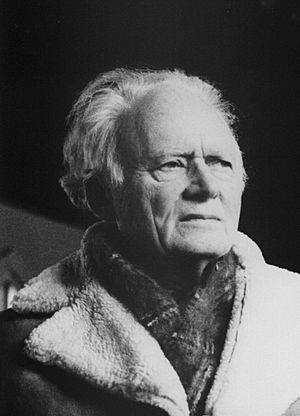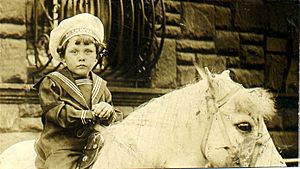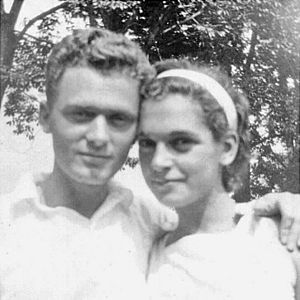Irving Adler facts for kids
Quick facts for kids
Irving Adler
|
|
|---|---|

Irving Adler at 75
|
|
| Born | 13 April 1913 |
| Died | 22 September 2012 (aged 99) |
| Nationality | American |
| Occupation | mathematician, writer |
| Relatives | Stephen L. Adler, Peggy Adler, Nathan Adler (psychologist) |
Irving Adler (born April 27, 1913 – died September 22, 2012) was an American author, mathematician, scientist, and educator. He wrote many books about math, science, and education for both kids and adults. Some of his books were published under the name Robert Irving. His books have been shared in 31 countries and 19 languages. From a young age, Adler was involved in social and political activities. He worked to support civil rights, civil liberties, and peace. He was even part of an important court case during the McCarthy era called Adler vs. Board of Education.
Contents
A Life of Learning and Teaching
Irving Adler was born in Harlem, New York City. He was the third of five children. His parents came to the United States from Galicia, which was part of Austria then. His father came first in 1906 to find work. His mother followed four years later. His father started a small business selling ice, coal, wood, and drinks.
Adler was first named Yitzchak, a Hebrew name. It was changed to Irving when he started elementary school. He was a very smart student and skipped grades five times. He entered Townsend Harris High School at age 11. He started City College (CCNY) when he was only 14. He won awards for his excellent work in math. He graduated from CCNY in 1931 when he was 18.
Adler started teaching at Stuyvesant High School. He then taught as a substitute teacher for three years. The Board of Education was not hiring regular teachers at the time. He joined the Unemployed Teachers Association. This group filed a lawsuit. Because of this, 3,500 teachers, including Adler, became regular teachers in one day. This meant they got full benefits.
In the 1930s, Adler was active in the student peace movement. There he met Ruth Relis, a student from Barnard College. They got married in 1935. Irving and Ruth Adler had two children, Stephen and Peggy.
Adler taught math at different New York City high schools. From 1946 to 1952, he led the math department at Straubenmuller Textile High School. He was also an active member of the New York City Teachers Union. He became a leader on its executive board.
Fighting for Rights: Adler v. Board of Education
In 1947, President Harry Truman ordered loyalty checks for government workers. New York State then passed the "Feinberg Law" in 1949. This law allowed teachers to be fired if they belonged to "subversive organizations." This was during a time known as the McCarthy era, when people were often questioned about their political beliefs.
The New York Teachers' Union challenged this law. They won a case in the New York State Supreme Court. But this decision was later overturned. The U.S. Supreme Court decided against the teachers in 1952. This case became known as Adler vs. Board of Education. Irving Adler's name was first alphabetically among the plaintiffs.
Before the Feinberg Law was fully in place, teachers were questioned. Union leaders and active members were asked if they were or had been members of the Communist Party. Many, including Adler, refused to answer. They said the question violated their rights. Because they refused to answer, Adler and others were fired. Adler was suspended in 1952 and officially dismissed in 1954.
Years later, in 1967, the U.S. Supreme Court changed its mind. They ruled differently in a new case. The teachers who had been fired in the 1950s then sued to get their jobs back. Adler was rehired and retired from the city schools in 1977. He also got his pension rights back.
A Career as an Author
Adler wrote his first science book for children, The Secret of Light, while he was still teaching. It was published in 1952. In 1955, he started working with the John Day Company. His first book with them was Time in Your Life. Most of Adler's books were published by John Day Company. He also had seven books published by Alfred A. Knopf under the name "Robert Irving." He wrote several others for Golden Press and Doubleday. For many years, Adler wrote six books a year. These books were mostly about science for junior-high and high-school students.
In 1958, Adler wrote a book for adults called The New Mathematics. This book was very important for the "New Math" curriculum reform movement. It led to him speaking at many educational meetings.
In 1959, Irving and Ruth Adler began writing "The Reason Why" series together. These books explained scientific ideas for elementary school children. Adler also wrote The Giant Golden Book of Mathematics. After that, he wrote a series of six math workbooks for grade-school children. These were called Mathematics - Grade 1 through Mathematics - Grade 6. His workbooks sold about 28 million copies around the world.
Irving and Ruth Adler moved to Shaftsbury, Vermont, in late 1960. In 1961, Irving Adler earned his doctorate in mathematics from Columbia University. After moving to Vermont, he continued his activism. He led a group against atomic weapons testing. He also led a group from Vermont to the 1963 March on Washington. He supported civil rights activities in the southern U.S.
Ruth Adler passed away from cancer in 1968. Later that year, Irving Adler married Joyce Sparer. She was a long-time family friend and a teacher. Irving and Joyce Sparer Adler wrote Language and Man together in 1970. After that, she wrote her own books. In 1977, Joyce's three children came to live with them. Adler then retired from writing full-time. In 1984, the Adlers went on a lecture tour around the world. They spoke at universities in Australia, New Zealand, Asia, and Europe.
Fibonacci Numbers and Plant Spirals
In the late 1970s, Adler became interested in phyllotaxis. This is the study of how plant spirals are arranged. These arrangements often follow the Fibonacci sequence. His writings in the Journal of Theoretical Biology helped bring new attention to this topic. In 2012, a collection of these papers was published in a book. It was called Solving the Riddle of Phyllotaxis. His son, Stephen L. Adler, wrote the foreword for the book. His daughter, Peggy Adler, drew the diagrams. Adler gave many talks about phyllotaxis at universities and conferences.
Honors and Awards
- Belden Gold Medal for Excellence in Mathematics (1927)
- National Science Foundation fellowship (1959)
- New York State Association for Supervision and Curriculum Development award for Outstanding Contributions to Children's Literature (1961) (with Ruth Adler)
- National Science Teachers Association/ Children's Book Council citations for Outstanding Science Books for Children (1972, 1975, 1980, and 1990)
- American Association for the Advancement of Science fellow (1982)
- Vermont Academy of Arts and Sciences fellow (1985)
- Saint Michael's College honorary Doctorate of Science (1990)
- Townsend Harris Hall of Fame (1996)
- Townsend Harris Medal
- City College of New York honorary Doctorate of Humane Letters (2002)
- Vermont ACLU lifetime achievement award (2009)
Works
- The Secret of Light (1952)
- Discover the Stars, (1954), with Gaylord Johnson
- Fire in Your Life (1955)
- Time in Your Life (1955)
- Hurricanes and Twisters, (1955), written as Robert Irving
- Rocks and Minerals and the Story They Tell, (1956), written as Robert Irving
- The Stars: Steppingstones Into Space (1956)
- Tools in Your Life (1956)
- What We Want From Our Schools (1957)
- Monkey Business: Hoaxes in the Name of Science (1957)
- Man-Made Moons (1957)
- Magic House of Numbers (1957)
- How Life Began (1957)
- Dust (1958)
- Mathematics: The Story of Numbers, Symbols and Space (1958)
- The New Mathematics (1958)
- The Sun and Its Family (1958)
- The Tools of Science (1958)
- Energy and Power, (1958), written as Robert Irving
- Weather in Your Life (1959)
- Seeing the Earth From Space (1959)
- Hot and Cold (1959)
- Sound and Ultrasonics, (1959), written as Robert Irving
- Temperature in Your Life (1960)
- Electromagnetic Waves, (1960) written as Robert Irving
- Light in Your Life (1961)
- Thinking Machines (1961)
- Electronics, (1961), written as Robert Irving
- The Adler Book of Puzzles and Riddles, (1962), with Peggy Adler
- Mathematics Workbook with Self-Teaching Text and Learning Exercises (1962)
- Color in Your Life (1962)
- Volcanoes and Earthquakes, (1962), written as Robert Irving
- Inside the Nucleus (1963)
- Probability and Statistics for Every Man (1963)
- A New Look at Arithmetic (1964)
- Logic for Beginners (1964)
- The Elementary Mathematics of the Atom (1965)
- Electricity in your Life (1965)
- A New Look at Geometry (1966)
- The Wonders of Physics (1966)
- Groups in the New Mathematics (1968)
- Mathematics and Mental Growth (1968)
Works Written with his wife, Ruth Adler
- Numbers Old and New (1960)
- Things that Spin (1960)
- Rivers (1961)
- Shadows (1961)
- The Story of a Nail (1961)
- Why? A Book of Reasons (1961)
- Your Eyes (1962)
- Oceans (1962)
- Insects and plants (1962)
- Air (1962)
- Storms (1963)
- Your Ears (1963)
- Why and How? (1963)
- The Earth's Crust (1963)
- Irrigation (1964)
- Numerals: New Dresses for Old Numbers (1964)
- Fibers (1964)
- Heat (1964)
- Houses (1964)
- Machines (1964)
- Coal (1965)
- Evolution (1965)
- Atoms and Molecules (1966)
- Taste, Touch and Smell (1966)
- Magnets (1966)
- Tree Products (1967)
- Sets (1967)
- The Calendar (1967)
- Communication (1967)
- Directions and Angles (1969)
- Sets and Numbers for the Very Young (1969)
See also
 In Spanish: Irving Adler para niños
In Spanish: Irving Adler para niños



